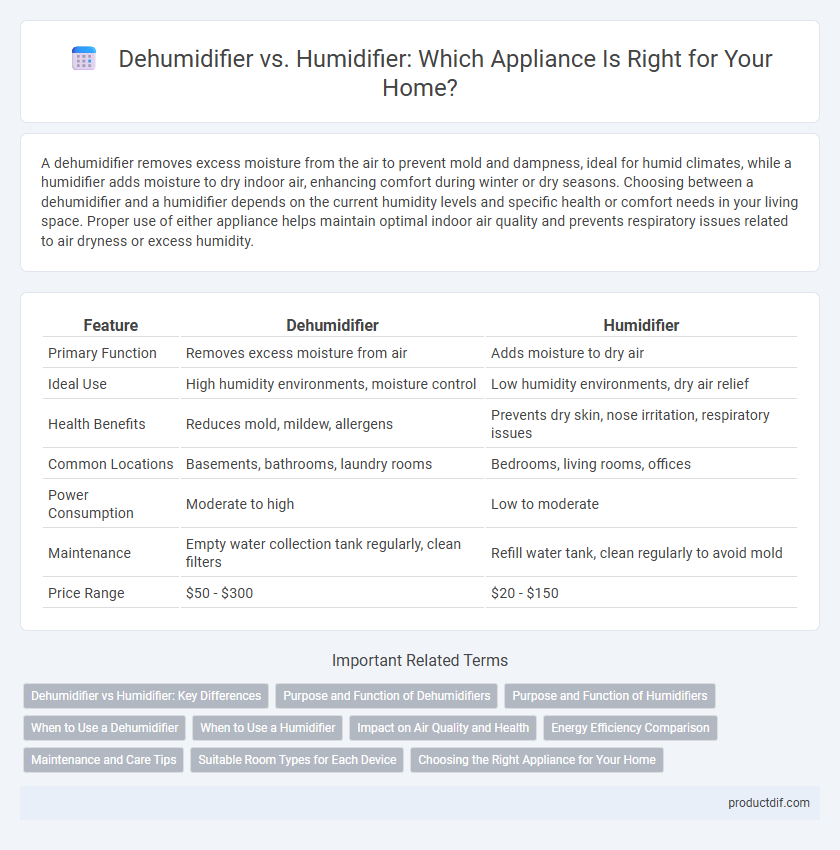A dehumidifier removes excess moisture from the air to prevent mold and dampness, ideal for humid climates, while a humidifier adds moisture to dry indoor air, enhancing comfort during winter or dry seasons. Choosing between a dehumidifier and a humidifier depends on the current humidity levels and specific health or comfort needs in your living space. Proper use of either appliance helps maintain optimal indoor air quality and prevents respiratory issues related to air dryness or excess humidity.
Table of Comparison
| Feature | Dehumidifier | Humidifier |
|---|---|---|
| Primary Function | Removes excess moisture from air | Adds moisture to dry air |
| Ideal Use | High humidity environments, moisture control | Low humidity environments, dry air relief |
| Health Benefits | Reduces mold, mildew, allergens | Prevents dry skin, nose irritation, respiratory issues |
| Common Locations | Basements, bathrooms, laundry rooms | Bedrooms, living rooms, offices |
| Power Consumption | Moderate to high | Low to moderate |
| Maintenance | Empty water collection tank regularly, clean filters | Refill water tank, clean regularly to avoid mold |
| Price Range | $50 - $300 | $20 - $150 |
Dehumidifier vs Humidifier: Key Differences
Dehumidifiers reduce excess moisture in the air, preventing mold growth and improving air quality, while humidifiers add moisture to dry air, alleviating dryness-related discomfort. Dehumidifiers are essential in damp environments to control humidity levels below 50%, whereas humidifiers are ideal in dry climates or during winter to maintain indoor humidity between 30-50%. The choice between a dehumidifier and humidifier depends on the specific indoor air quality needs and seasonal changes affecting humidity balance.
Purpose and Function of Dehumidifiers
Dehumidifiers reduce excess moisture in the air to prevent mold growth, allergens, and damage to furniture, improving indoor air quality. They work by drawing humid air over cooling coils, condensing the moisture into a collection tank or drainage system. Unlike humidifiers that add moisture, dehumidifiers maintain balanced humidity levels by extracting water vapor from the environment.
Purpose and Function of Humidifiers
Humidifiers increase indoor humidity by releasing moisture into the air, alleviating dryness that can cause irritation in the skin, throat, and respiratory system. They are essential in environments with low humidity levels, especially during winter months, to maintain optimal air moisture for comfort and health. Humidifiers also help preserve wooden furniture and musical instruments by preventing warping caused by dry air.
When to Use a Dehumidifier
Use a dehumidifier when indoor humidity levels exceed 50%, causing discomfort, mold growth, or damage to wood and electronics. Ideal for basements, bathrooms, and areas prone to dampness or condensation. A dehumidifier maintains optimal air quality by reducing allergens and preventing mildew in high-moisture environments.
When to Use a Humidifier
Use a humidifier when indoor air becomes dry, especially during winter months or in arid climates, to add moisture and alleviate symptoms like dry skin, irritated sinuses, and static electricity. Ideal humidity levels range from 30% to 50%, promoting comfort and protecting wooden furniture, houseplants, and musical instruments from damage caused by dryness. Humidifiers benefit individuals with respiratory issues, colds, or allergies by maintaining optimal indoor air quality and preventing excessive dryness.
Impact on Air Quality and Health
Dehumidifiers reduce excess moisture, preventing mold growth and reducing allergens, which improves respiratory health and air quality. Humidifiers add moisture to dry air, alleviating symptoms of dry skin, throat irritation, and respiratory discomfort, especially in winter. Proper use of both appliances balances indoor humidity levels, optimizing comfort and minimizing risks linked to airborne irritants and pathogens.
Energy Efficiency Comparison
Dehumidifiers typically consume more energy than humidifiers due to their refrigeration-based moisture removal process, which requires running compressors. Humidifiers generally use less power by releasing moisture through ultrasonic or evaporative methods, making them more energy-efficient for indoor humidity control. Energy efficiency ratings and usage patterns should be compared when selecting either appliance for optimal cost savings and environmental impact.
Maintenance and Care Tips
Regularly cleaning the filters and water tanks of both dehumidifiers and humidifiers prevents mold growth and ensures efficient operation. For dehumidifiers, emptying the collection bucket and checking the coils for dust buildup extends the appliance's lifespan. Humidifiers require routine refilling with distilled water and disinfection to avoid bacteria proliferation and maintain optimal air quality.
Suitable Room Types for Each Device
Dehumidifiers are ideal for damp or humid spaces such as basements, bathrooms, and laundry rooms where excess moisture causes mold and mildew growth. Humidifiers work best in dry areas like bedrooms or living rooms to add moisture and relieve dry skin, allergies, and respiratory issues. Selecting the right device depends on the room's humidity level and specific air quality needs.
Choosing the Right Appliance for Your Home
Selecting between a dehumidifier and a humidifier depends on your home's air quality needs: dehumidifiers reduce excess moisture to prevent mold and allergens, while humidifiers add moisture to dry environments to ease respiratory issues and skin dryness. For homes in humid climates or with damp basements, a dehumidifier effectively controls humidity levels, maintaining optimal indoor comfort and protecting wooden furniture. Conversely, in areas with low humidity or during winter months, a humidifier improves air moisture, enhancing comfort and protecting nasal passages and wooden floors from drying out.
Dehumidifier vs Humidifier Infographic

 productdif.com
productdif.com